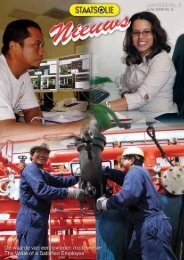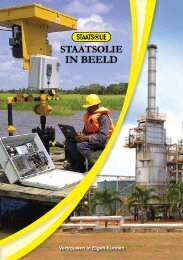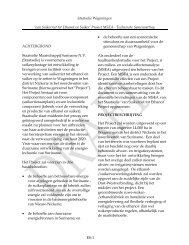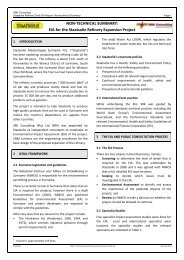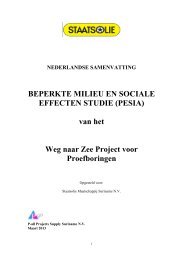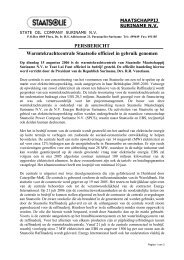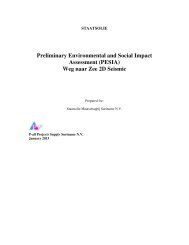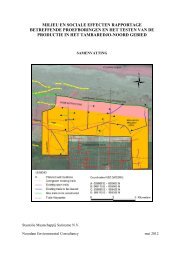(PESIA) Weg naar Zee 2D Seismic - Staatsolie
(PESIA) Weg naar Zee 2D Seismic - Staatsolie
(PESIA) Weg naar Zee 2D Seismic - Staatsolie
You also want an ePaper? Increase the reach of your titles
YUMPU automatically turns print PDFs into web optimized ePapers that Google loves.
P-all consultants <strong>Staatsolie</strong> Maatschappij Suriname N.V.<br />
<strong>PESIA</strong> <strong>Weg</strong> <strong>naar</strong> <strong>Zee</strong> <strong>2D</strong> <strong>Seismic</strong> 2012<br />
the poisonous Labaria or Owrokuku snake (Bothrops atrox) is rather common. Especially in de<br />
rainy season, these snakes concentrate in higher areas and hide during the day below all kinds of<br />
debris, solid waste including garbage.<br />
During the fieldtrips the following reptile was observed: Groene tuinhagedis (Ameiva ameiva).<br />
4.3.3.4 Fishes<br />
According to Mol, ichthyologist and contributor to the Tambaredjo baseline study (IBT, 1999),<br />
the fish fauna of the Tambaredjo Swamp is typical for the coastal plain and no rare or<br />
endangered species of fish are found in that area.<br />
For the freshwater swamp (commercial and sport) fisheries, the most important catch consists of<br />
"Kwikwi" (Hoplosternum and Callichthys spp), "Krobia" (mainly Aequidens spp.), Pataka<br />
(Hoplias malabaricus) and Walapa (Erythrinus erythrinus).<br />
Because of possible spills during drilling a special fish survey was conducted in both the swamp<br />
and in the Brantimakaweg area.<br />
Fish was assessed at Canal Brantimaka weg (N0553132, W05511265) and Canal <strong>Staatsolie</strong><br />
pomp at Okrodam (N0552200, W0551511) on August 2012. Low depths areas in the canals were<br />
seined for an hour, where after gillnets were set overnight. Below the list with fish species found<br />
at the assessed locations.<br />
Brantimaka weg<br />
Staatolie pomp Okrodam<br />
Micropecilia parae Atsyanax bimaculatus<br />
Poecilia vivipara Ctenobrycon spilurus<br />
Rivulus stagnates Pristella maxillaries<br />
Polycentrus schomburgkii Crenicichla saxatillis<br />
Cichlasoma bimaculatum Polycentrus schomburgki<br />
Eleotris pisonis Cichlasoma bimaculatum<br />
Hoplias marabaricus Micropecilia parae<br />
Tarpon atlanticus<br />
Tarpon atlanticus<br />
Hoplias marabaricus<br />
Poecilia reticulate<br />
4.3.3.5 Invertebrates<br />
Biting and stinging insects and mites can make a stay in the Wayambo Swamp very<br />
uncomfortable. During daytime various flies may become a nuisance like the “brokoston” and<br />
“kawfre” (Tabanidae). At night and especially during the early evening, there are millions of<br />
stinging mosquitos (such as Taenorhynchys and Aedes species). As far as known, these insects<br />
do not transmit any diseases, but without preventive measures (long sleeves, insect-repellants,<br />
mosquito-nets, screened working spaces) they may cause persons to lose patience and cause<br />
panic, which may lead to unsafe behavior and accidents. It is assumed that the mosquitoes play a<br />
role in the spreading of dengue fever.<br />
52




